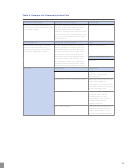Community Action Plan
ADVERTISEMENT
Action Step 8. Build the Community Action Plan
The final action step for completing CHANGE is to build the Community Action Plan. Careful
execution of the previous seven action steps makes this task fairly straightforward. A quality plan
contains sufficient details to map a clear course of action. Table 5 shows an example of a Community
Action Plan. As you complete the Community Action Plan and craft the objectives, be sure they are
SMART—specific, measurable, achievable, realistic, and time-phased. The definition of a SMART
objective is explored in more detail in Figure 17. Of particular importance in this example is the
presence of two objectives: project period objective and annual objective. The project period objective
allows your team to look at the big picture of what can be accomplished over a multi-year period.
For example, in Table 5, the project period objective is by Year 3 increase the percent of total miles of
physical infrastructure for walking by 30%. Always provide a description of the project period objective
to give context for what your team hopes to achieve (e.g., the establishment of sidewalks, trails, or
walking paths across the community). As you think about your work, narrow the focus to certain
chronic diseases and conditions and their related risk factors, such as obesity and physical inactivity.
Concentrating on these priority areas rather than a broader view will enable your team to craft very
specific, actionable objectives with real impact.
Annual objectives cover a 12-month timeframe and show incremental progress toward completion
of the project period objective. As with the project period objective, it is important to provide a
description of the annual objective. In Table 5, only one annual objective, at the end of 12 months,
increase percent of developments (e.g., housings, schools, and commercial) with paved sidewalks to 100%,
is listed for the project period objective. However, your team could write two additional annual
objectives that address trails and walking paths to fully achieve the project period objective. Similar
to the Community Health Improvement Planning Template in Action Step 7, it is important to
associate each annual objective with a particular sector. You may develop multiple annual objectives
that cut across more than one sector for a project period objective. While, in this example, the sector
impacted is Community-At-Large Sector, a second objective could be developing trails around senior
centers, which would impact the Community Institution/Organization Sector. For each annual
objective, indicate the number of people reached through its successful completion. Reach is the
extent to which a policy affects the intended audience. Think about how many people will be affected
by a sidewalk ordinance requiring paved sidewalks for all developments.
The final section of the Community Action Plan template is where you list the activities that support
the accomplishment of an annual objective. When listing activities, be sure to provide a title and clear
descriptions of key milestones. Avoid listing tactical tasks in this section. For example, the town hall
meeting is more significant than the telephone calls your team makes to secure the time, date, and
location of the meeting. The activities listed in Table 5 serve as examples; for each annual objective
the recommendation is to list no more than ten activities, which may limit these activities to key
actions for completing the annual objective.
39
ADVERTISEMENT
0 votes
Related Articles
Related forms
Related Categories
Parent category: Business
 1
1 2
2 3
3








